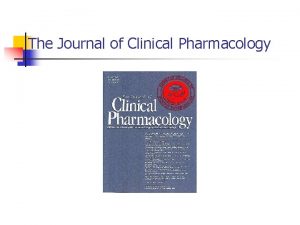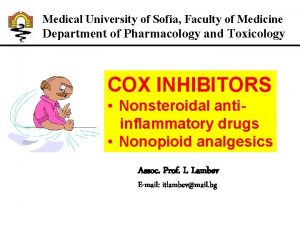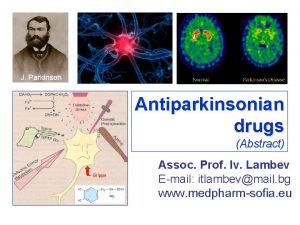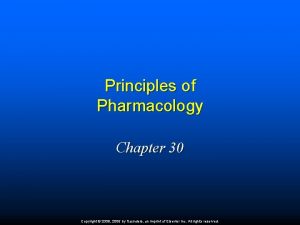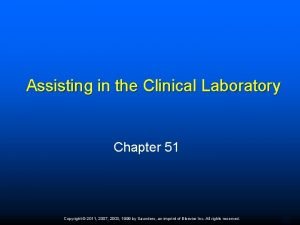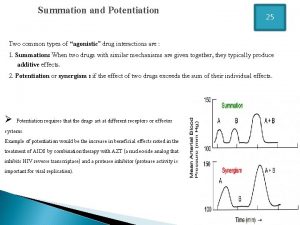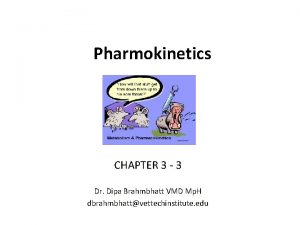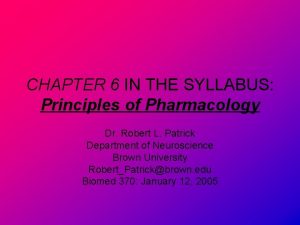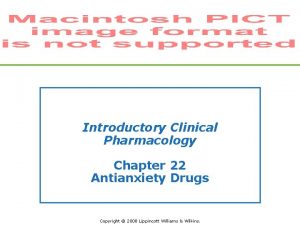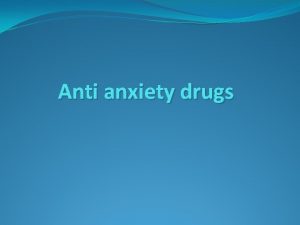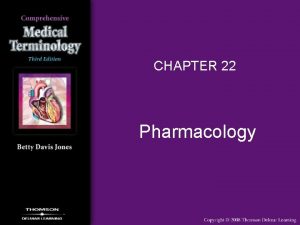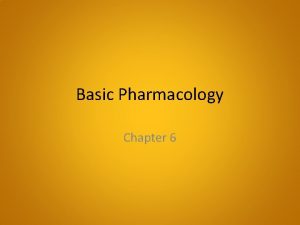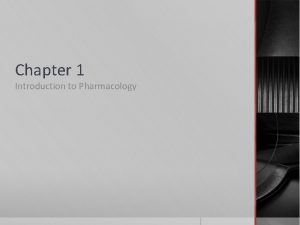Introduction to Clinical Pharmacology Chapter 20 Antianxiety Drugs






























- Slides: 30

Introduction to Clinical Pharmacology Chapter 20 Antianxiety Drugs Copyright © 2014 Wolters Kluwer Health | Lippincott Williams & Wilkins

Introduction to Antianxiety Drugs Antianxiety drugs or anxiolytics Benzodiazepines: long-term use can result in physical dependence or psychological addiction Nonbenzodiazepines: useful antianxiety drugs Copyright © 2018 Wolters Kluwer · All Rights Reserved

Antianxiety Drugs: Actions Anxiolytic drugs: block neurotransmitter receptor sites Benzodiazepines: potentiate effects of gamma-aminobutyric acid Nonbenzodiazepines: exert effect in various ways Buspirone: acts on serotonin receptors Hydroxyzine: acts on hypothalamus and brainstem reticular formation Copyright © 2018 Wolters Kluwer · All Rights Reserved

Figure 20. 1 Benzodiazepine drugs bind to a site on the cell receptor, potentiating the effect of GABA (an inhibitory neurotransmitt er) on the receptor. Copyright © 2018 Wolters Kluwer · All Rights Reserved

Antianxiety Drugs: Uses Isolated episodes of intense anxiety Temporary use for those with severe functional impairment Preanesthetic Convulsions Alcohol sedatives, muscle relaxants or seizures withdrawal Copyright © 2018 Wolters Kluwer · All Rights Reserved

Antianxiety Drugs: Adverse Reactions Early reactions: mild drowsiness or sedation, lightheadedness or dizziness, and headache Other adverse body system reactions: Lethargy, apathy, fatigue Disorientation, anger, restlessness Nausea, constipation or diarrhea, dry mouth Visual disturbances Copyright © 2018 Wolters Kluwer · All Rights Reserved

Antianxiety Drugs: Dependence Long-term use: results in physical drug dependence and tolerance Withdrawal symptoms may occur with as few as 4 to 6 weeks of therapy with benzodiazepines Nursing Alert Symptoms of benzodiazepine withdrawal: increased anxiety, concentration difficulties, tremors, and sensory disturbances Copyright © 2018 Wolters Kluwer · All Rights Reserved

Copyright © 2018 Wolters Kluwer · All Rights Reserved

Antianxiety Drugs: Contraindications Patients: hypersensitivity, psychoses, and acute narrow-angle glaucoma During pregnancy (category D) and labor due to floppy infant syndrome manifested by sucking difficulties, lethargy, hypotonia in the newborn Lactating women In patients in coma or shock or if vital signs of patient in acute alcoholic intoxication are low Copyright © 2018 Wolters Kluwer · All Rights Reserved

Antianxiety Drugs: Precautions Used cautiously with elderly patients and patient-impaired: Liver function Kidney function Debilitation Copyright © 2018 Wolters Kluwer · All Rights Reserved

Antianxiety Drugs: Interactions Interactant drug Effect of interaction Alcohol Increased risk for central nervous system (CNS) depression or convulsions Analgesics Increased risk for CNS depression Tricyclic antidepressants, antipsychotics Increased risk for sedation and respiratory depression Digoxin Increased risk for digitalis toxicity Copyright © 2018 Wolters Kluwer · All Rights Reserved

Nursing Process: Assessment #1 Preadministration Nurse assessment obtains medical history, mental status, anxiety level before initiating therapy Physical assessment, physiologic manifestations of anxiety Copyright © 2018 Wolters Kluwer · All Rights Reserved

Nursing Process: Assessment #2 Ongoing assessment Check blood pressure before drug administration Periodically monitor mental status and anxiety level Ask patient or family about adverse effects of drug Document general summary of patient’s outward behavior, complaints, or problems Copyright © 2018 Wolters Kluwer · All Rights Reserved

Nursing Process: Nursing Diagnosis and Planning Nursing diagnoses Risk for Injury related to dizziness or hypotension and gait problems Impaired Comfort related to dryness in gastrointestinal (GI) tract from medications Ineffective Individual Coping related to situation causing anxiety Expected patient outcome: optimal response to drug therapy, knowledge of and compliance with prescribed therapeutic regimen, managing adverse drug reactions Copyright © 2018 Wolters Kluwer · All Rights Reserved

Nursing Process: Implementation #1 Promoting an optimal response to therapy During initial therapy the nurse observes for adverse drug reactions The antianxiety drugs are not recommended for long-term use If used for short periods (1 to 2 weeks), tolerance, withdrawal, and dependence do not usually develop Report Copyright © 2018 Wolters Kluwer · All Rights Reserved

Nursing Process: Implementation #2 Monitoring and managing patient needs: Risk for injury During outpatient therapy the nurse should instruct the family and patient about adverse reactions Gerontologic alert: Lorazepam and oxazepam Buspirone Nursing care plan Copyright © 2018 Wolters Kluwer · All Rights Reserved

Nursing Process: Implementation #3 Monitoring and managing patient needs (cont. ) Monitoring Instruction Sedation, drowsiness Intramuscular administration Parenteral administration Copyright © 2018 Wolters Kluwer · All Rights Reserved

Nursing Process: Implementation #4 Impaired comfort Cause Nursing interventions Administer Meals include fiber, fruits, and vegetables to aid in preventing constipation Careful with oral route due to dry mouth causing swallowing problems Copyright © 2018 Wolters Kluwer · All Rights Reserved

Nursing Process: Implementation #5 Ineffective individual coping Outpatient: the nurse observes the patient for response to therapy at time of each clinic visit Question about response to therapy; use open-ended questions Once anxiety reduced the nurse may be able to help patient identify precipitation of panic/cause of anxiety Copyright © 2018 Wolters Kluwer · All Rights Reserved

Nursing Process: Implementation #6 Ineffective individual coping (cont. ) Important to help patient understand there are health care providers who can help them gain coping skills Benzodiazepine toxicity Flumazenil Adverse reactions to flumazenil include agitation, confusion, seizures, and, in some cases, symptoms of benzodiazepine withdrawal, relieved with administration of benzodiazepine Copyright © 2018 Wolters Kluwer · All Rights Reserved

Nursing Process: Implementation #7 Educating the patient and family The nurse needs to evaluate the patient’s ability to assume responsibility for taking the drugs at home The nurse explains adverse effects of specific drugs and encourages the patient and family to contact primary health care provider if serious adverse effects occur Copyright © 2018 Wolters Kluwer · All Rights Reserved

Nursing Process: Implementation #8 Educating the patient and family (cont. ) Teaching Take plan: drug as directed Avoid performing hazardous tasks, alcohol Do not discontinue drugs abruptly Do not take OTC drugs or supplements without consulting primary health care provider Inform dentist, physicians, and health care providers of your therapy Copyright © 2018 Wolters Kluwer · All Rights Reserved

Nursing Process: Implementation #9 Educating the patient and family (cont. ) Teaching plan (cont. ) If dizziness occurs when changing positions do so slowly; if severe, ask for help Eat food rich in fiber to prevent constipation Keep all appointments with primary health care provider Report any unusual changes Copyright © 2018 Wolters Kluwer · All Rights Reserved

Nursing Process: Implementation #10 Evaluation Therapeutic effect achieved Patient reports decrease in feelings of anxiety Adverse reactions identified, reported to health care provider Verbalize importance of complying with prescribed therapeutic regimen Copyright © 2018 Wolters Kluwer · All Rights Reserved

Question #1 Is the following statement true or false? Anxiety involves a feeling of apprehension, worry, or uneasiness that may or may not be based on reality. Copyright © 2018 Wolters Kluwer · All Rights Reserved

Answer to Question #1 True Anxiety involves a feeling of apprehension, worry, or uneasiness that may or may not be based on reality. Anxiety is a normal feeling, yet as anxiety increases it can interfere with day-to-day functioning. Because it is a subjective feeling, patients can be asked to rate anxiety similar to rating pain. Copyright © 2018 Wolters Kluwer · All Rights Reserved

Question #2 Is the following statement true or false? Benzodiazepines and nonbenzodiazepine anxiolytics are used to treat anxiety on a long-term basis. Copyright © 2018 Wolters Kluwer · All Rights Reserved

Answer to Question #2 False Benzodiazepines and nonbenzodiazepine anxiolytics are used to treat anxiety on a short-term basis. Physical and psychological dependence can occur with the use of these drugs; typically, psychiatric anxiety disorders (that need long-term treatment) use antidepressants for treatment instead of benzodiazepines. Copyright © 2018 Wolters Kluwer · All Rights Reserved

Question #3 Is the following statement true or false? Benzodiazepine doses should always be tapered and never stopped abruptly; withdrawal can occur with symptoms such as a return of anxiety, concentration problems, tremors, and sensory disturbances. Copyright © 2018 Wolters Kluwer · All Rights Reserved

Answer to Question #3 True Benzodiazepine doses should always be tapered and never stopped abruptly; withdrawal can occur with symptoms such as a return of anxiety, concentration problems, tremors, and sensory disturbances. Copyright © 2018 Wolters Kluwer · All Rights Reserved
 Pharmacology of drugs acting on respiratory system
Pharmacology of drugs acting on respiratory system Adrenal drugs pharmacology
Adrenal drugs pharmacology Clinical pharmacology powered by clinicalkey
Clinical pharmacology powered by clinicalkey Clinical pharmacology
Clinical pharmacology Basic & clinical pharmacology
Basic & clinical pharmacology Dopamine synthesis
Dopamine synthesis Basic & clinical pharmacology
Basic & clinical pharmacology Clinical pharmacology residency
Clinical pharmacology residency Clinical pharmacology seminar
Clinical pharmacology seminar Clinical pharmacology seminar
Clinical pharmacology seminar Slidetodoc. com
Slidetodoc. com Competitive antagonist
Competitive antagonist Chapter 30 principles of pharmacology
Chapter 30 principles of pharmacology Chapter 15 diagnostic procedures and pharmacology
Chapter 15 diagnostic procedures and pharmacology Pharmacology chapter 1
Pharmacology chapter 1 Chapter 45 introduction to the clinical laboratory
Chapter 45 introduction to the clinical laboratory Venipuncture for radiologic technologists
Venipuncture for radiologic technologists Drug summation examples
Drug summation examples Zero order elimination drugs
Zero order elimination drugs What is ion trapping in pharmacology
What is ion trapping in pharmacology Glucouronide
Glucouronide First pass effect
First pass effect What is pharmacology
What is pharmacology First pass effect in pharmacology
First pass effect in pharmacology What are the different routes of drug administration
What are the different routes of drug administration Receptors in pharmacology
Receptors in pharmacology First pass effect
First pass effect Npte pharmacology
Npte pharmacology What is pharmacology
What is pharmacology What is ion trapping in pharmacology
What is ion trapping in pharmacology What is pharmacology
What is pharmacology



